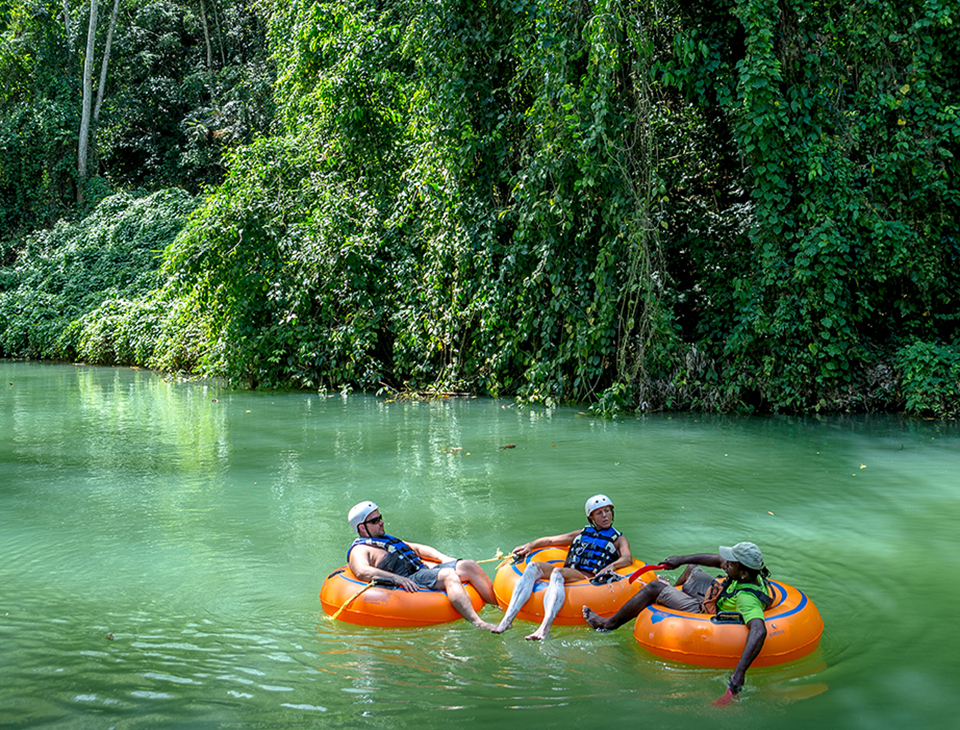By Sarah Greaves-Gabbadon
CJ Travel Editor
Caribbean beaches get all the love. And really, who doesn’t adore sugary sands, Windex-blue water and palm-fringed coastlines? But in destinations such as Jamaica, where rushing rivers wind their way through the landscape, to see only the beaches is to miss out on an opportunity to enjoy the country in much more revealing way.
That was my experience last weekend at River Bumpkin Farm, a 59-acre estate in the hilly interior of Trelawny. Part of the Retreat Estate, a working plantation which grows bananas, pumpkin, potatoes, coconut and plantains, the farm offers excursions via kayak and inner tube along the upper reaches of the Martha Brae River.
Outfitted in life jackets and helmets, a couple of friends and I launched ourselves into a trio of bright orange tubes, which were tethered to each other and to our guide, Dancer. Lanky and lithe with a playful personality, he wielded two pink plastic paddles with deceptive ease, powering our flotilla on its almost two-mile journey along the undulating water with long, fluid strokes. Transformed into the color of tea by recent rains, and punctuated with lace-like foam in places where it spilled over jutting rocks and branches, the river transported us not only through Jamaica’s lush interior but also back in time.
As we bobbed along, Dancer pointed out the vegetation on its banks: towering logwood trees with silver-grey trunks; flourishing stands of bamboo he told us can grow up to three inches overnight; Jamaica’s national tree, the Blue Mahoe; breadfruit trees laden with the bumpy green orbs; and petite guava trees.
As he maneuvered to the bank and picked us one of the yellow-skinned fruit to try, Dancer explained how, during the colonial era, this land sustained the slaves, who supplemented their meager diets with its bounty. And how the river was used not just for bathing and drinking water but also as a source for the water mills that powered the estate’s sugar factory.
Even the limestone found on the riverbed was put to good use, not just for construction but also as a healing poultice for cuts and skin conditions when mixed with water.
Although I’d been crestfallen when we were advised not to bring our phones or cameras on the roughly 90-minute transit, my disappointment had the unexpected upside of forcing me be fully present in the moment.
So I paid keen attention to the turtle basking on the muddy bank, and marveled at the blue egret that swooped low above our heads, looking for its lunch in the depths.
Floating gently under centuries-old stone bridges with birdsong as our soundtrack and gentle breezes kissing our skin, it felt as if we were some of the first visitors to the island. In this primordial setting, with the sun dappling our legs through the forest canopy and the fresh scent of damp earth in the air, I had a precious glimpse of the pastoral paradise Jamaica must have been, long before all the high-rise resorts, cruise ships and sunburned tourists.
And I wondered: How many people have the chance to see this side of the irie isle? How many visitors make the effort to venture beyond the beach to magical settings like this, where the classic Caribbean “sun/sea/sand” trifecta lacks two of three elements but is none the worse for it?
Back at home in Miami, I got my answer. In an email, local tour company Island Routes Adventures, which owns and sells the excursion through hotels across the island, told that since it opened in June 2014, more than 5,000 visitors have had the Bumpkin experience.
I feel lucky to have been one of them.
